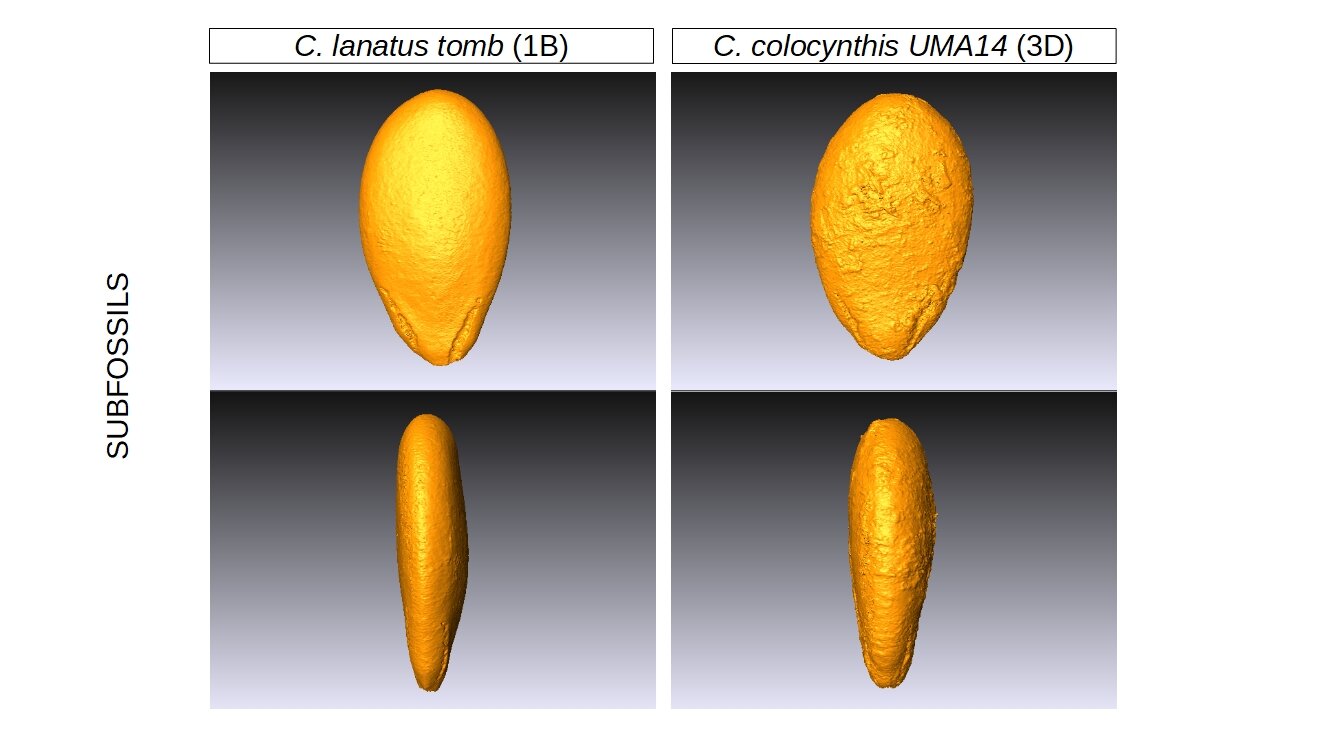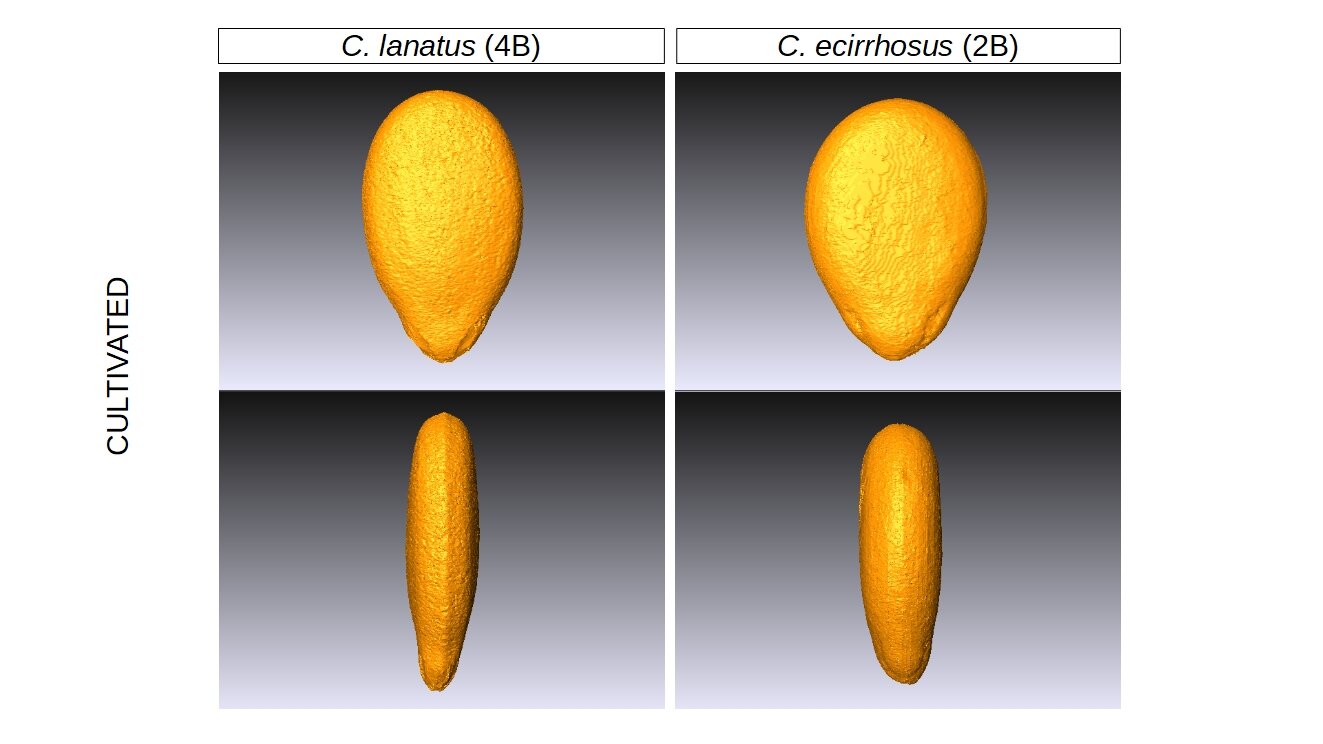3D Analysis of Ancient Domesticated Watermelons (Citrullus sp.)
Volume transformations of a ~4,000 year-old Bitter Cucumber (Citrullus colocynthis) seed fossil found in Uan Muhuggiag, Libya (micro-CT dataset shown in Amira v5.4).
Humans began domesticating plants roughly 12,000 years ago during the Neolithic Revolution (Fuller et al. 2014, Arranz-Otaegui et al. 2018). Plant domestication is a process that includes generations of selective breeding from an unpalatable or even toxic ancestor to produce plump, tasty cultivars like many of our favorite supermarket fruits and vegetables, including apples, tomatoes, and potatoes.
Historically, the steady food supply from agriculture lead to
the formation of settlements (instead of moving seasonally like hunter-gatherers)
population growth
division of labor to plant, harvest and store crops
Thus, learning when, where and by whom crops were domesticated gives us important clues about human civilization and could even include information beyond what is known from written records (reviewed in Kantar et al. 2017, for an example in the southwestern USA with maize, see da Fonseca et al. 2015). For example, if closely-related cultivated seeds were found in two distant archaeological sites, it could indicate the two civilizations were connected by trade. In recent years, stories of trade routes and domestication have come out of genetic studies on maize, cassava, and sweet potato to name a few (for examples, see Kistler et al. 2018, Bredeson et al. 2016, Roullier et al. 2013).
"PEI Potato Farm" by John Beales is licensed under CC BY-NC-SA 2.0.
"Watermelons" by Ahmad is licensed under CC BY-NC 2.0.
"A Monkey Eating Watermelon in the Sea" by gordon.b.anderson is licensed under CC BY-NC 2.0.
"Watermelon 3" by Clover_1 is licensed under CC BY-NC 2.0.
Watermelons (Citrullus lanatus (Thunberg) Matsumura & Nakai) are a major global crop with over 100 million tons of fruit produced annually on 3 million hectares of land (Paris 2015 numbers based on http://faostat.fao.org/site/339/default). Despite their agricultural importance, there is still uncertainty to exactly when and where domesticated watermelons originated. The oldest archaeological evidence is from Uan Muhuggiag, Libya (5,000 and 8,650 years old - also where one of our samples is from!) and from Tutankhamun’s (King Tut’s) tomb in Egypt (3,000 years old - we also have one of these samples) and conflicting studies suggest African origins in South Africa, the Nile valley, or West Africa (Wasylikowa and van der Veen 2004, Van der Veen 2011, Paris 2015, Renner et al. 2017, Renner et al. 2019, Chomicki and Renner 2015).
To get clarity on this important (and delicious) crop, we are investigating 6 of 7 known species of ancient and modern domesticated watermelons (Citrullus sp.) using DNA and 3D morphology. By comparing different species, we will be able to see which are most closely related, when and where they diverged from each other and if there are any noticeable differences in overall seed shape that early farmers may have used as cues for selective breeding.
Check out our watermelon seeds yourself
Interact with our 3D models of a watermelon seed from King Tut’s tomb (left) and a modern-day cultivated seed (right). You can also download the datasets used for analysis in our upcoming publication (Wolcott et al. 2021, Plants, People, Planet) from MorphoSource.
The watermelon is among the world's most important fruit crops 🍉@kmeanskatie, @Chomicki_G, @Economicbotany, @ssrenner, @YanStaed and colleagues used 3D X-ray-computed tomography to study the oldest known seeds 👇https://t.co/ybomBMe18K
— Plants People Planet 🌱👥🌐 (@plantspplplanet) August 9, 2021
Here's what they found 🧵 [1/6] pic.twitter.com/rFqBgdLHU3
Surface models of all watermelon species (Citrullus sp.) that we are investigating from modern cultivated samples and subfossils collected from King Tut’s (Tut Ankh Amun) Tomb, Egpyt and an unknown priest’s tomb in Uan Muhuggiag, Libya.
Project Publication
Wolcott, Chomicki, Staedler ... and Renner 2021. 3D X-ray-computed tomography of 3300 to 6000-year-old Citrullus seeds from Libya and Egypt compared to extant seeds throws doubts on species assignments. Plants, People, Planet. doi.org/10.1002/ppp3.10220
References
Arranz-otaegui, A., Gonzalez, L., Ramsey, M. N., Fuller, D. Q., & Richter, T. (2018). Archaeobotanical evidence reveals the origins of bread 14 , 400 years ago in northeastern Jordan. 115(31), 7925–7930. https://doi.org/10.1073/pnas.1801071115
Bredeson, J. V, Lyons, J. B., Prochnik, S. E., Wu, G. A., Ha, C. M., Edsinger-Gonzales, E., … Rokhsar, D. S. (2016). Sequencing wild and cultivated cassava and related species reveals extensive interspecific hybridization and genetic diversity. Nature Biotechnology, 34(5), 562–570. https://doi.org/10.1038/nbt.3535
Chomicki, G., & Renner, S. S. (2015). Watermelon origin solved with molecular phylogenetics including Linnaean material: another example of museomics. New Phytologist, 205(2), 526–532. https://doi.org/10.1111/nph.13163
da Fonseca, R. R., Smith, B. D., Wales, N., Cappellini, E., Skoglund, P., Fumagalli, M., … Gilbert, M. T. P. (2015). The origin and evolution of maize in the Southwestern United States. Nature Plants, 1(1), 14003. https://doi.org/10.1038/nplants.2014.3
Fuller, D. Q., Denham, T., Arroyo-kalin, M., Lucas, L., Stevens, C. J., Qin, L., & Allaby, R. G. (2014). Convergent evolution and parallelism in plant domestication revealed by an expanding archaeological record, 111(17). https://doi.org/10.1073/pnas.1308937110
Kantar, M. B., Nashoba, A. R., Anderson, J. E., Blackman, B. K., & Rieseberg, L. H. (2017). The Genetics and Genomics of Plant Domestication. BioScience, 67(11), 971–982. https://doi.org/10.1093/biosci/bix114
Kistler, L., Maezumi, S. Y., Souza, J. G. De, Przelomska, N. A. S., Costa, F. M., Smith, O., … Arriaza, B. (2018). Multiproxy evidence highlights a complex evolutionary legacy of maize in South America. 1313(December), 1309–1313.
My brother Chris Wolcott, PhD and history buff, for sharing his knowledge on things that he is “pretty sure [he’s] rememebering right” on anthropology and early agriculture (2020).
Paris, H. S. (2015). Origin and emergence of the sweet dessert watermelon, Citrullus lanatus. Annals of Botany, 116(2), 133–148. https://doi.org/10.1093/aob/mcv077
Renner, S. S., Perez-Escobar, O. A., Silber, M. V., Nesbitt, M., Preick, M., Hofreiter, M., & Chomicki, G. (2019). A 3500-year-old leaf from a Pharaonic tomb reveals that New Kingdom Egyptians were cultivating domesticated watermelon. https://doi.org/10.1101/642785
Renner, S. S., Sousa, A., & Chomicki, G. (2017). Chromosome numbers, Sudanese wild forms, and classification of the watermelon genus Citrullus, with 50 names allocated to seven biological species. TAXON, 66(6), 1393–1405. https://doi.org/10.12705/666.7
Roullier, C., Duputié, A., Wennekes, P., Benoit, L., Fernández Bringas, V. M., Rossel, G., … Lebot, V. (2013). Disentangling the Origins of Cultivated Sweet Potato (Ipomoea batatas (L.) Lam.). PLoS ONE, 8(5), e62707. https://doi.org/10.1371/journal.pone.0062707
Van der Veen, M. (2011). Consumption, trade and innovation, exploring the botanical remains from the Roman and Islamic Ports at Quseir al-Qadim, Egypt. Frankfurt am Main: Africa Magna. pages 106–110 and 179–185.
Wasylikowa, K., & van der Veen, M. (2004). An archaeobotanical contribution to the history of watermelon, Citrullus lanatus (Thunb.) Matsum. & Nakai (syn. C. vulgaris Schrad.). Vegetation History and Archaeobotany, 13(4), 213–217. https://doi.org/10.1007/s00334-004-0039-6








